Physical Address
304 North Cardinal St.
Dorchester Center, MA 02124
In order to properly evaluate congenital corneal clouding, a thorough history and examination must be performed with a low threshold to obtain an examination under anesthesia. Ancillary testing with A-scan ultrasound biometry, B-scan ultrasonography, ultrasound biomicroscopy, and anterior segment optical coherence tomography may be helpful.
STUMPED is a useful mnemonic for categorizing the many causes of congenital cloudy corneas. This mnemonic will be utilized throughout this chapter. In addition, an alternate classification scheme is proposed based on clinical phenotype, underlying genetic mutations, and the likely pathophysiology of a given abnormality.
Glaucoma should always be considered, either as the primary etiology of cloudy cornea or as a secondary problem.
Topical prophylaxis with erythromycin at birth is effective in preventing many causes of neonatal conjunctivitis.
Neonatal herpes simplex virus infections with or without ocular involvement must be treated with systemic antiviral therapy.
Peters anomaly is characterized by a central corneal opacity with possible iris and lens abnormalities caused by defects in the posterior stroma, endothelium, and Descemet membrane. Unlike Peters anomaly, congenital anterior staphyloma is associated with a large corneal opacity in the setting of a disorganized anterior segment and typically carries a worse prognosis.
Corneal dermoids are benign congenital tumors that most frequently occur at the inferotemporal limbus and may be associated with systemic conditions.
The term congenital designates conditions present at birth. Congenital corneal opacities may result from genetic, developmental, traumatic, or infectious causes. They can be unilateral or bilateral and can be seen in isolation or in association with other ocular or systemic abnormalities. The prevalence of congenital corneal opacity is approximately 3per100,000 newborns, and this figure increases to 6per100,000 if congenital glaucoma is included as an underlying etiology. A recent analysis of congenital corneal opacities in New York found an incidence of 1 infant corneal transplant per 24,000 live births. Although congenital clouding of the cornea is rare, the ophthalmologist must make an accurate diagnosis to predict the natural history of the disorder, detect associated ocular and systemic abnormalities, provide genetic counseling if needed, and promptly begin appropriate medical or surgical therapy. This chapter addresses the main features and differential diagnosis of the most common causes of congenital corneal opacification ( Box 18.1 ). It also discusses an alternative classification scheme based not only on clinical appearance but also underlying genetic mutations and the likely pathophysiology of the given abnormality ( Box 18.2 ).
| S | Sclerocornea |
| T | Tears in the Descemet membrane Congenital glaucoma Birth trauma |
| U | Ulcer Bacterial Viral Neurotrophic |
| M | Metabolic (rarely present at birth) Mucopolysaccharidoses Mucolipidoses Miscellaneous syndromes |
| P | Posterior corneal defect Peters anomaly Posterior keratoconus Congenital anterior staphyloma |
| E | Endothelial dystrophy Congenital endothelial dystrophy Posterior polymorphous corneal dystrophy Congenital stromal corneal dystrophy |
| D | Dermoid |
Primary corneal disease
Corneal dystrophies
Congenital hereditary endothelial dystrophy
Posterior polymorphous corneal dystrophy
Congenital hereditary stromal dystrophy
X-linked endothelial corneal dystrophy
Corneal dermoid
Peripheral sclerocornea
CYP1B1 cytopathy
Secondary corneal disease
Congenital
Kerato-irido-lenticular dysgenesis
Iridocorneal adhesion (Peters type 1)
Lens fails to separate from cornea (Peters type 2)
Lens separates but fails to form thereafter
Lens separates and forms but there is late corneal apposition
Lens fails to form
Irido-trabecular dysgenesis
Primary congenital glaucoma (most commonly CYP1B1 and LTBP2 mutations)
Intracorneal cyst
Acquired
Infection
Trauma
Metabolic
Thorough evaluation of congenital corneal clouding begins with a complete history and physical examination. A detailed obstetric, birth, and family history may be helpful in identifying many diseases. With regards to an obstetric and birth history, it is important to inquire about prenatal drug and infectious exposures, including sexually transmitted infections, as well as the type of delivery and the use of assisted devices. After obtaining a complete history, examination of the newborn and the eyes must occur. A quick survey of the infant from head to toe can help to identify potentially associated systemic findings, and the use of a handheld portable slit lamp may facilitate a careful anterior segment examination. If the patient is cooperative, assessment of corneal sensation can be very helpful in narrowing the differential diagnosis. A cotton fiber can be used to touch the cornea while movement of the other lid is used as an indicator of corneal sensation. In cases where it is not possible to open the lids manually, a speculum may be used with topical anesthesia in the outpatient setting in order to provide adequate exposure for a detailed examination. Nonetheless, sometimes a thorough examination may be best accomplished by placing the patient under general anesthesia with the collaboration of a pediatric anesthesiologist, pediatric ophthalmologist, and cornea and glaucoma specialists when available ( Fig. 18.1 ). Last, examination of the patient’s parents while they are in the office may also be helpful in order to establish the diagnosis of various inherited conditions.
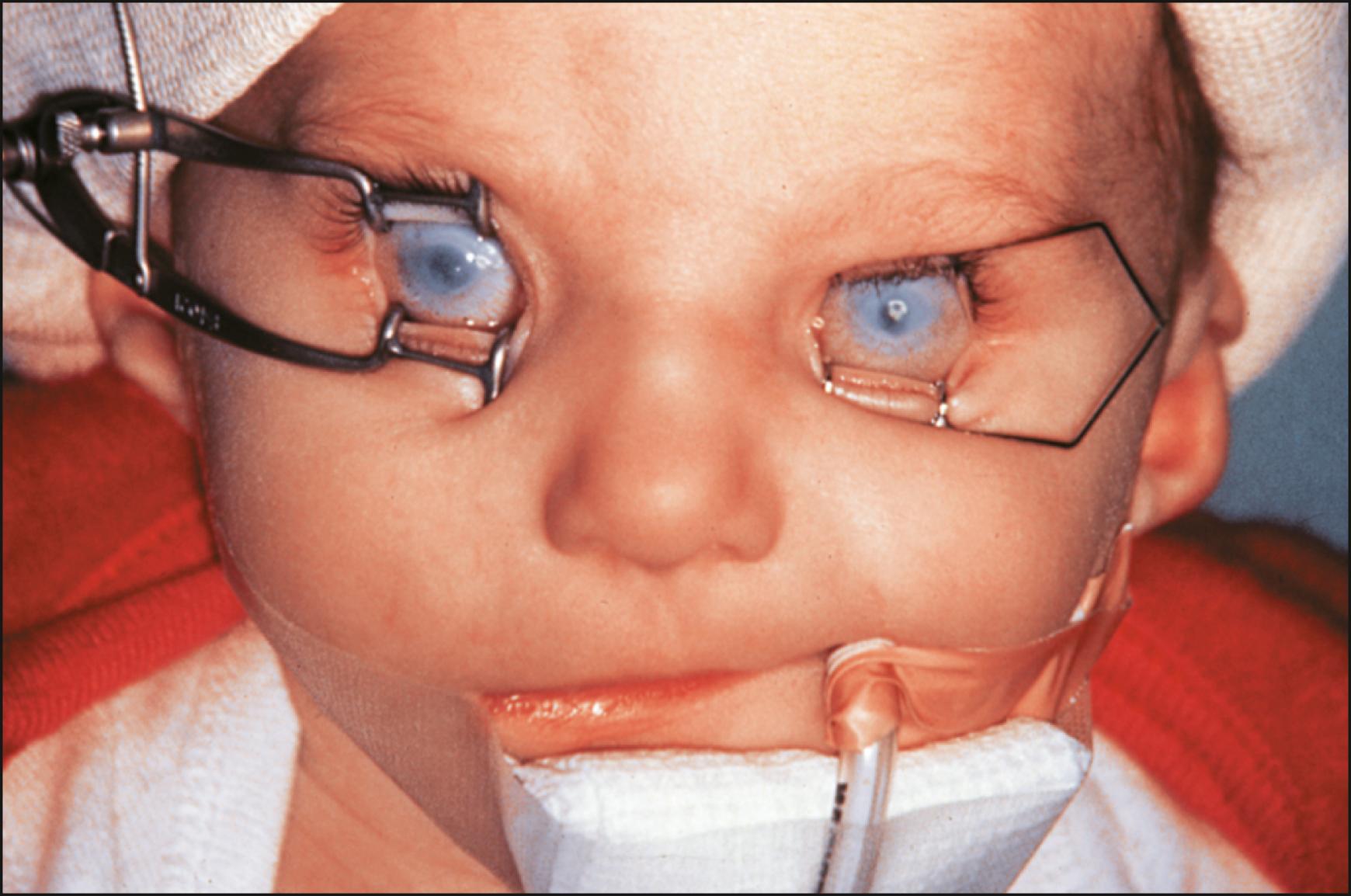
Components of a complete examination under anesthesia (EUA) include measurement of the intraocular pressure (IOP), corneal pachymetry, measurement of corneal diameters (both vertically and horizontally with calipers), and biomicroscopic examination of the cornea and anterior segment with and without fluorescein. Depending on the degree of corneal opacification, gonioscopy, dilated fundus examination, and retinoscopy may be attempted. During an EUA, advanced imaging modalities including A-scan ultrasound biometry (A-scan), B-scan ultrasonography (B-scan), high-frequency ultrasound biomicroscopy (UBM), and anterior segment optical coherence tomography (AS-OCT) can more easily be performed. Biomicroscopic examination must be performed with a handheld portable slit lamp, as the level of magnification and the presence of a slit beam make the slit lamp far superior to the operating microscope for corneal evaluation. Often, visualization through a cloudy cornea can be extremely limited, especially if the clouding is diffuse and dense. The view may be improved during an EUA by mechanically removing the epithelium. An EUA can also be helpful when an infectious etiology is suspected and corneal cultures are needed. In suspected unilateral conditions, the healthy eye must be thoroughly examined to look for any abnormalities, as bilateral disease can often present asymmetrically, which may give clues as to the final diagnosis.
In order to assess what is abnormal, one must know what is considered normal in the infant eye. Stated normals for IOP, corneal thickness, corneal diameters, and axial length in the neonate and infant are listed in Box 18.3 but reviewed in more detail here. Accurate IOP measurement is critical and should be performed either in an awake infant or early in the induction of anesthesia. General anesthesia typically lowers IOPs, which in premature infants has a mean of 10.11 ± 2.21 mm Hg. As mentioned earlier, corneal diameters should be measured with calipers in both the horizontal and vertical meridians. At birth, the corneal diameter ranges between 9.5 and 10.5 mm and increases to 11.5 mm by age 1 year. Measurements greater than 11.5 mm or marked asymmetry between the eyes should raise suspicion. Numerous studies have looked at ranges of IOP with and without anesthesia in newborns and infants. These ranges can be wide, although it is agreed that children have lower normal values than those stated for adults. , Several devices are available for IOP testing—including the gold standard, Goldmann applanation—as well as portable options including portable applanation (Perkins, Draeger), indentation tonometry (Schiotz, pneumotonometer, Tono-Pen), and rebound tonometers (i-Care). Another less portable option for intraocular measurement, which may be easier to perform in children than Goldmann applanation, is the noncontact tonometer (“air-puff tonometry”); but this requires awake patients who can position their chins correctly on the device. In the pediatric population, rebound tonometers such as the i-Care work well in awake patients including newborns; but they require an upright position and are prone to error. In the operating room environment, indentation tonometry or portable applanation are the most readily available and can provide more reliable measurements. One study demonstrated the pneumotonometer to be the most accurate in children whereas the TonoPen was the least. Corneal pachymetry is now easily obtained using a variety of handheld devices that utilize ultrasonic technology, including the iPac (Reichert) and Pachymate (DGH Technology, Inc.). Gonioscopy in the neonate may best be accomplished using a Koeppe lens and the operating microscope rotated to the correct angle for viewing. In the office, a Koeppe lens and the indirect ophthalmoscope with a 20-diopter (D) lens may also give an adequate view of the angle. Dilation of the pupil can sometimes expose the pupillary opening to areas of clear cornea, facilitating a view of the posterior segment despite a large corneal opacity ( Fig. 18.2 ). The direct ophthalmoscope can be used with a Koeppe lens to obtain a good view of the optic nerve and the macula. An indirect ophthalmoscope with a 14D lens can also be used to examine the disc, and with a 20 or 28D lens for the macula and peripheral retina. Retinoscopy should be done if possible, but this can be difficult through a cloudy cornea. Despite the challenges of performing a dilated examination in the presence of a corneal opacity, it is necessary to rule out concomitant causes of poor vision, including optic nerve abnormalities, macular scars, or other types of retinal pathology, including chorioretinal coloboma. If an adequate view cannot be obtained despite dilation, additional imaging modalities of the posterior segment should be employed. A-scan can determine the position of the iris and the lens as well as the axial length of the eye. B-scan provides excellent-quality imaging of the vitreous and retina and can reliably identify posterior segment abnormalities. For additional evaluation of the anterior segment, UBM and AS-OCT can be performed. UBM has been widely used for imaging the anterior segment structures of the eye with exceptional resolution ( Fig. 18.3 ). Some studies have demonstrated that UBM is capable of delineating the corneal layers except for distinguishing between the Descemet membrane and endothelium. UBM examination is not only very useful in making a clinical diagnosis but can also aid in planning prior to penetrating keratoplasty. UBM can readily detect iridocorneal and keratolenticular adhesions as well other ocular abnormalities such as aniridia, congenital, aphakia, and abnormalities posterior to the iris, including ciliary body masses or irregularities. Awareness of these types of anterior segment abnormalities can aid surgical planning and reduce surgical complications. AS-OCT, once limited to the outpatient setting, can now also be performed intraoperatively with the advent of handheld OCT devices. This technology, similar to UBM, can identify the presence of iridocorneal adhesions, keratolenticular adhesions, and features of anterior staphyloma. It can also perform biometry and measure the depth of the anterior chamber as well as the thickness of the cornea. Advantages over the UBM include that it is a noncontact device, has quick image acquisition times, and uses infrared technology, which is helpful in photophobic patients. Disadvantages, however, include a limited ability to image structures posterior to the iris and its shallower depth of penetration.
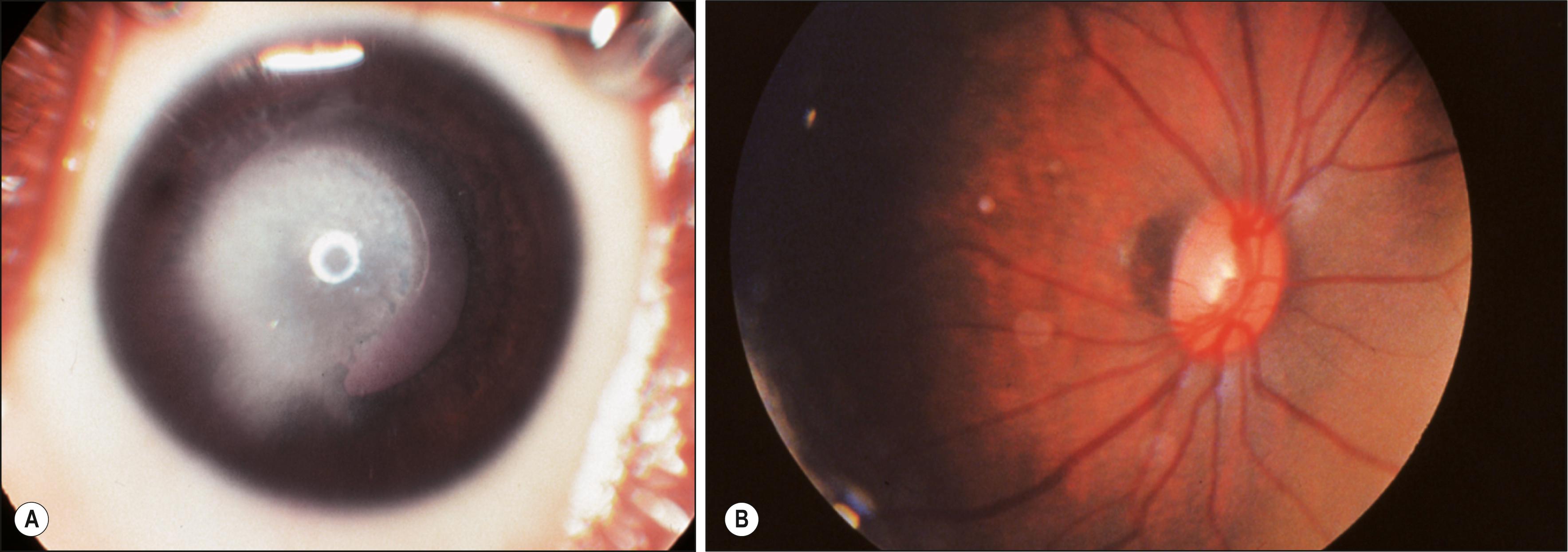
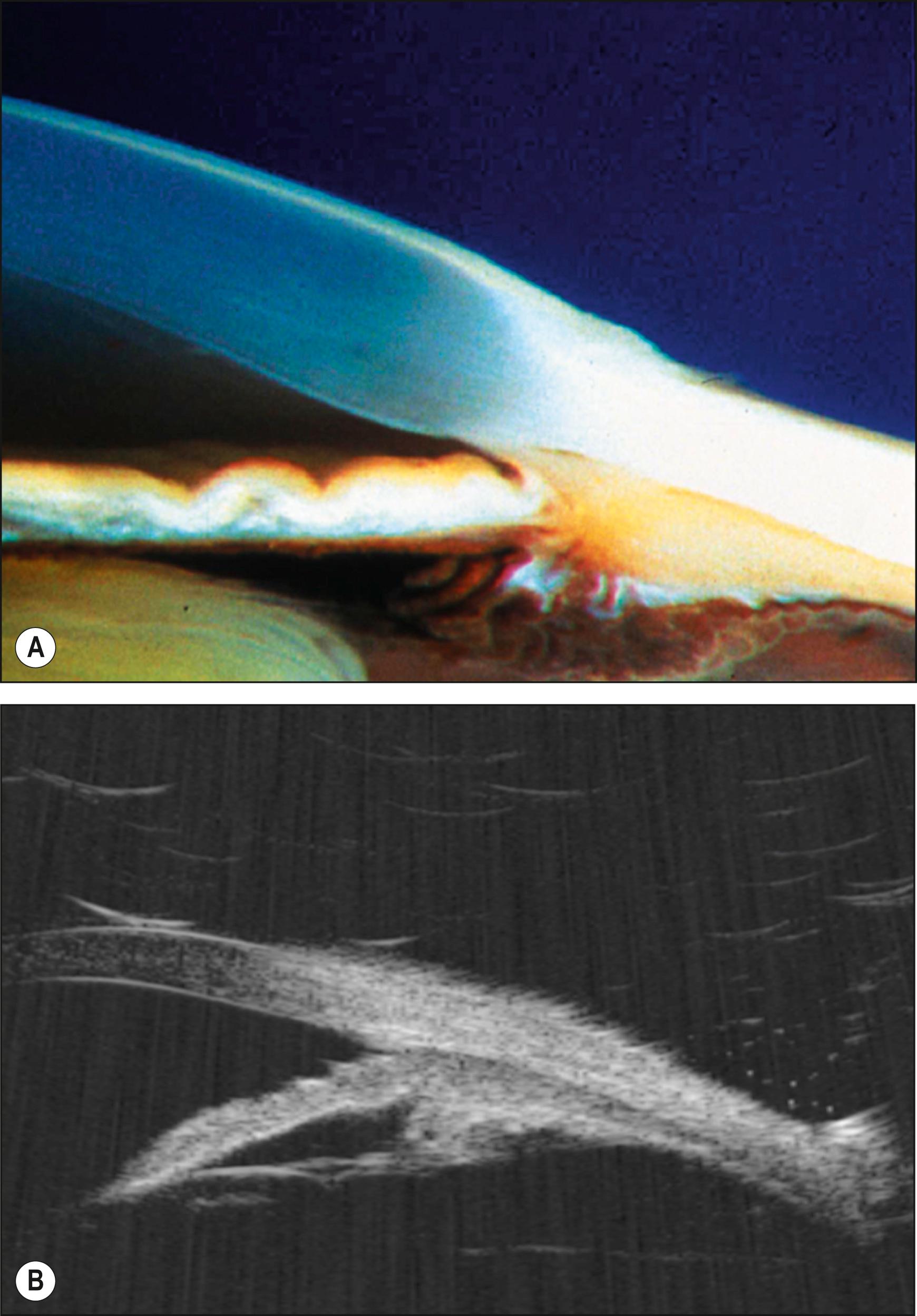
With these examination considerations in mind, one can then refer to the STUMPED mnemonic developed by Waring and colleagues to reach a possible diagnosis (see Box 18.1 ). Although this mnemonic can serve as a useful framework for creating a differential diagnosis, it does not differentiate between disease entities with similar phenotypes and different underlying etiologies. Thus we propose a new approach to the classification of neonatal corneal opacities (see Box 18.2 ).
Sclerocornea is a primary anomaly that involves scleralization of usually the peripheral part of the cornea occurs ( Fig. 18.4 ). Occasionally, sclerocornea involves the entire cornea ( Fig. 18.5 ). It may be an isolated finding or present in conjunction with other ocular defects. It generally appears sporadically but can also be autosomal dominant. The embryogenesis and genetics of sclerocornea are discussed in more detail in discussed in more detail in later chapters of this book. Sclerocornea is nonprogressive and usually bilateral, though commonly asymmetric (see Fig. 18.1 ). The opacification of the cornea is smooth, white, and vascular. Clinically, it appears to be an extension of the sclera into the cornea without limbal landmarks; typically it is greater peripherally than centrally. The vessels are fine continuations of conjunctival vessels, but deep vascularization can sometimes occur. Waring and Rodrigues have classified sclerocornea into the following four groups , :
Isolated peripheral sclerocornea
Sclerocornea plana
Sclerocornea associated with cleavage anomalies of the anterior chamber
Total sclerocornea
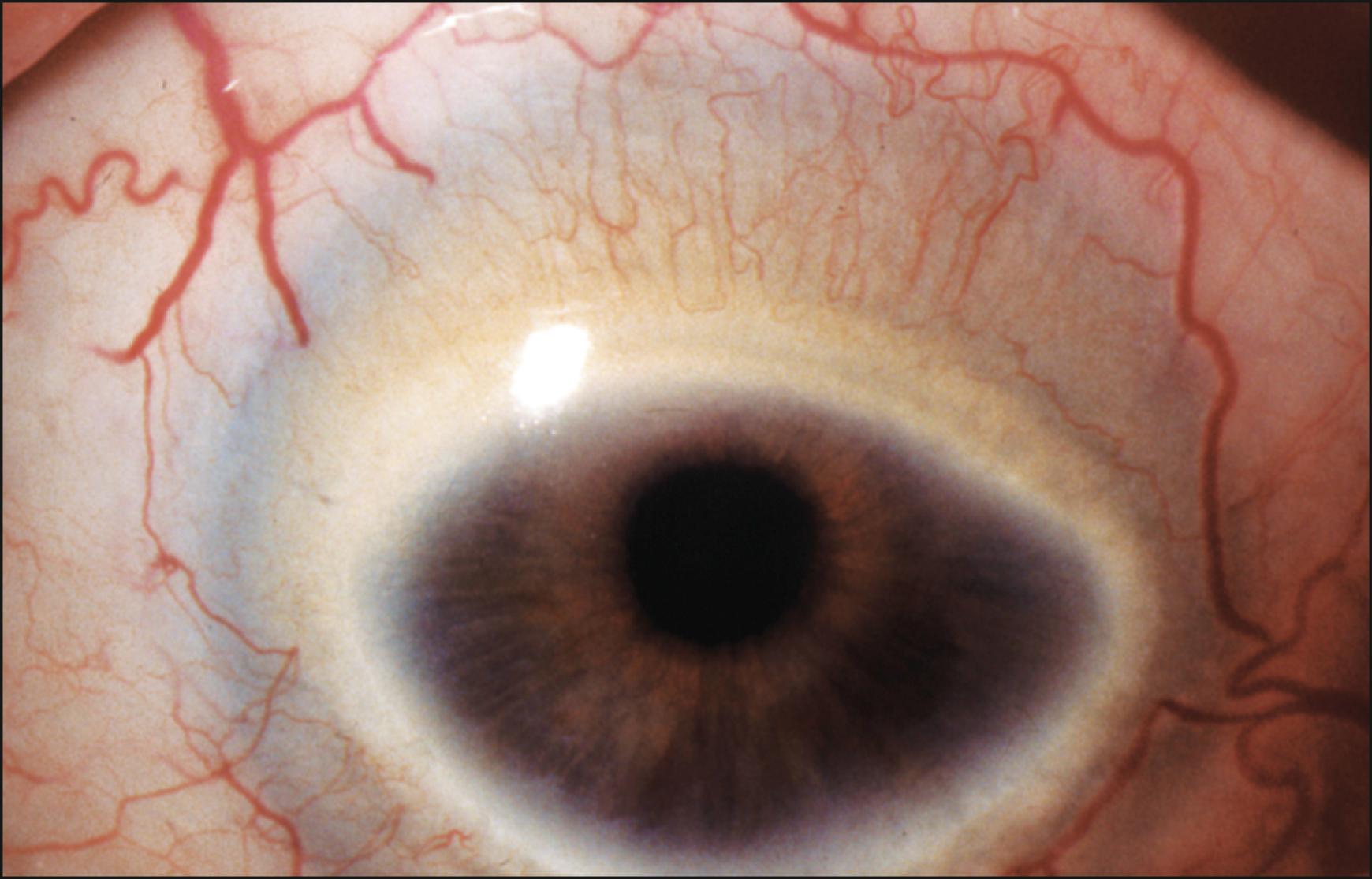
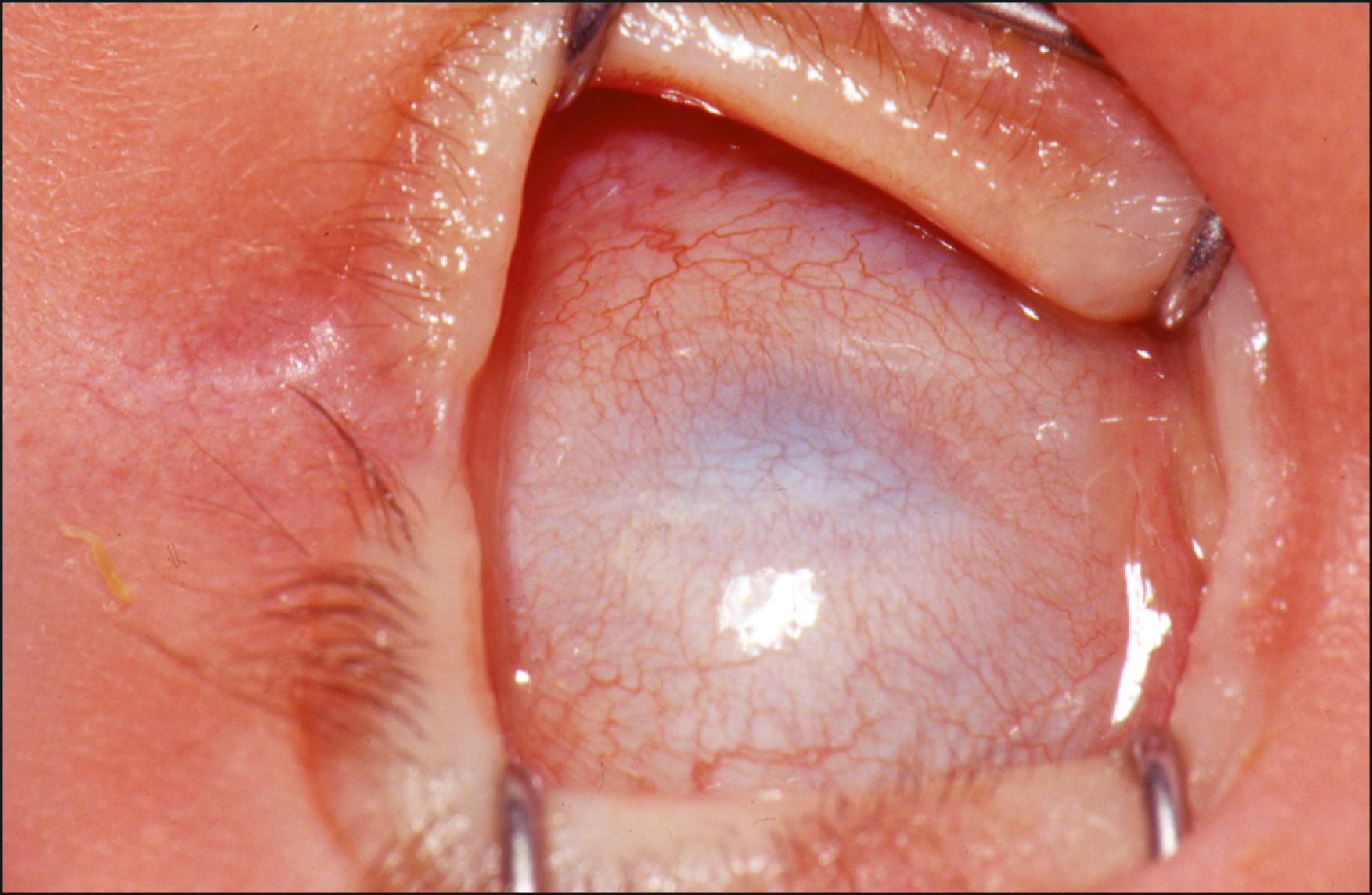
Isolated peripheral sclerocornea is diagnosed when there is an abrupt change from sclera-like tissue to clear cornea without other ocular abnormalities (see Fig. 18.4 ). Sclerocornea plana is diagnosed in the setting of a flat cornea with a keratometry readings of less than 38D and associated high hyperopia. The anterior chamber is usually shallow, but glaucoma is uncommon. Pseudoptosis can be seen because the flat cornea supports the upper lid poorly. Sharkey et al. reported an association with epidermolysis bullosa dystrophica. Reduced corneal sensitivity has also been reported. Sclerocornea associated with anterior chamber cleavage anomalies is diagnosed when sclerocornea is seen in the setting of other anterior segment anomalies, particularly Peters anomaly, characterized by paracentral iridocorneal or keratolenticular adhesions. Total sclerocornea is the most common form of sclerocornea causing congenital corneal opacity (see Fig. 18.5 ). The cornea is totally opaque and vascularized, but the central cornea is not as densely opacified as the peripheral cornea. The opacification generally affects the full-thickness of the stroma and thereby significantly limits visualization of the endothelium, pupil, and anterior chamber structures. Patients with sclerocornea sometimes exhibit systemic abnormalities including developmental delay and anomalies of the skin, face, ears, cerebellum, and testes. A list of ocular and systemic abnormalities associated with sclerocornea can be found in discussed in more detail in later chapters of this book. Histopathologically, the corneal stroma in sclerocornea resembles sclera. Precisely arranged corneal stromal lamellae are absent, and stromal vascularization is often present ( Fig. 18.6 ). Electron microscopy has also shown that the collagen fibrils of the corneal stroma are arranged irregularly and are variable in caliber. Most notably, their diameter is often markedly increased (up to 1500 Å), resembling the diameter of scleral fibrils ( Box 18.4 ). UBM and AS-OCT can assist in making the diagnosis of the sclerocornea ( Fig. 18.7 ) and facilitate surgical planning. ,
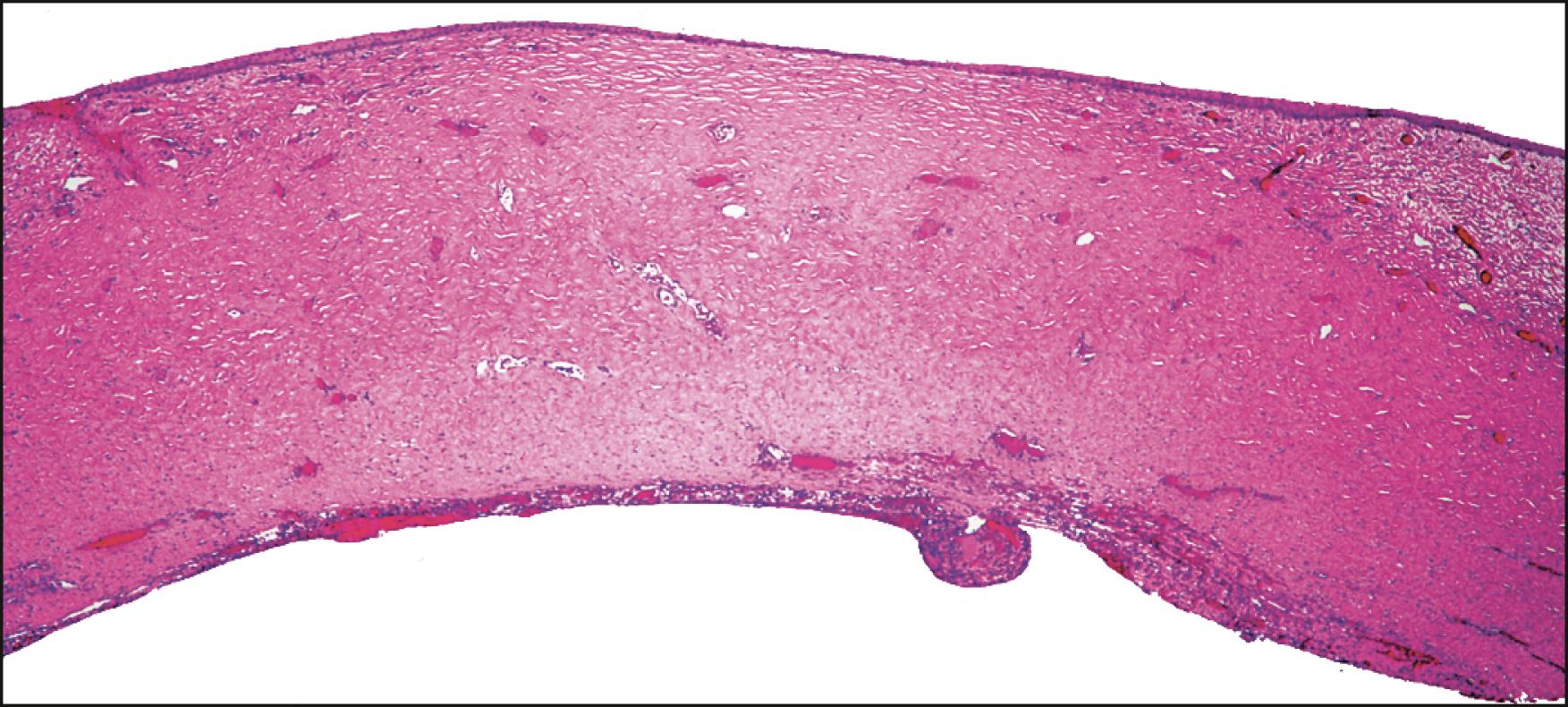
Corneal stroma resembles sclera morphologically.
Precise arrangement of stromal lamellae absent.
Irregular arrangement of collagen fibers; variable in diameter.
Collagen fibrils thickened (up to 1500 Å in diameter); resemble scleral fibrils.
Diameter of collagen fibrils decreases in posterior stroma.
Changes in posterior cornea may resemble those seen in Peters anomaly.
Descemet membrane attenuated or absent.
Central concave defect in the posterior corneal stroma (posterior ulcer).
Disorderly stromal lamellae in ulcer bed.
Absence of corneal endothelium and Descemet membrane in the posterior ulcer.
Corresponding area of central corneal edema and opacification.
Keratolenticular adhesions to posterior cornea in some cases.
Iridocorneal adhesions to margin of ulcer in some cases.
Bowman layer thickened or absent.
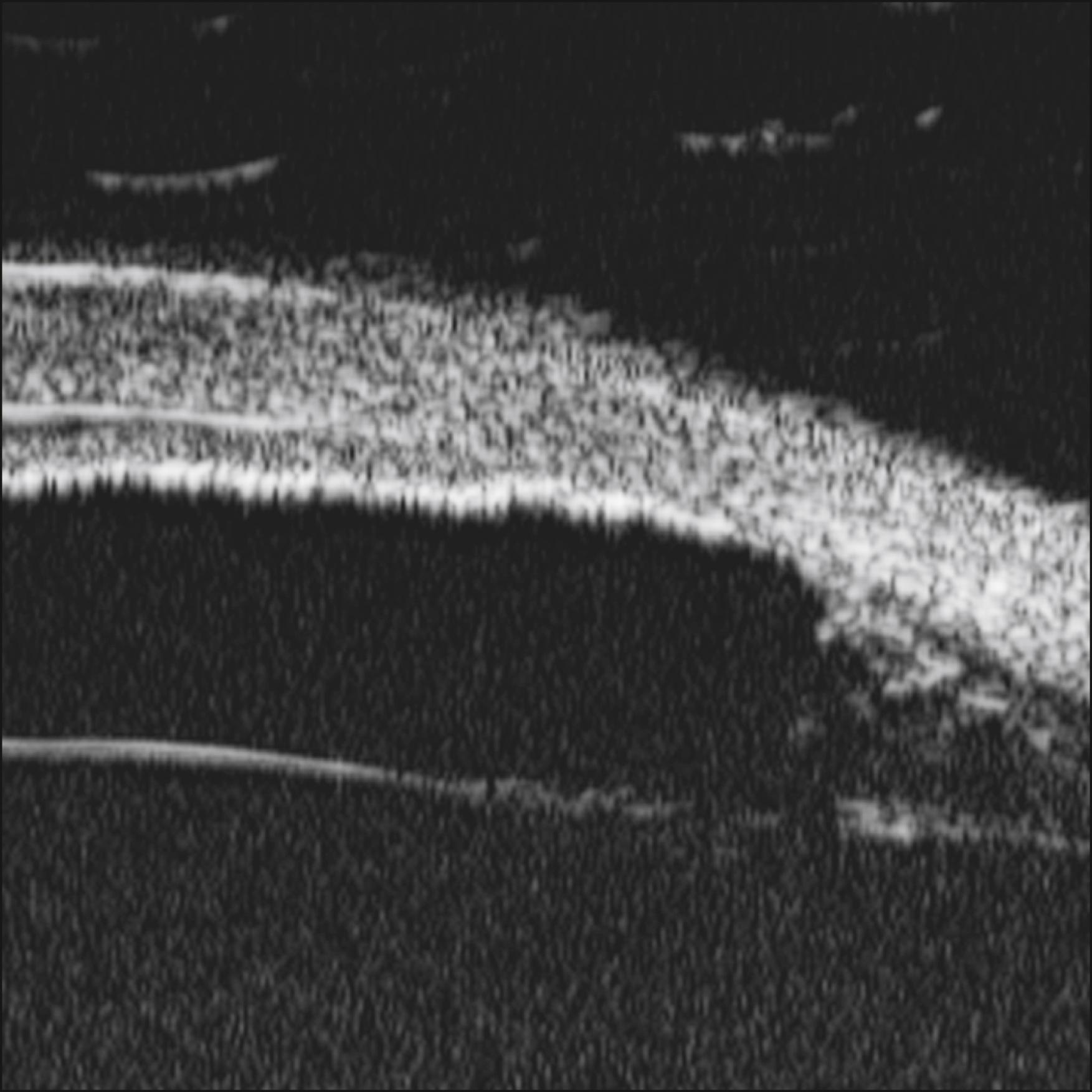
The differential diagnosis of sclerocornea includes arcus juvenilis, interstitial keratitis, Peters anomaly, and microcornea, but it can be narrowed by history, clinical examination, the presence of ocular and systemic associations, and observation of the patient over time ( Table 18.1 ). Management is similar to that of other congenital corneal opacities. If the disorder is unilateral and the other eye has good visual acuity, the decision to operate becomes more difficult; in such a case surgery should be performed only if other ocular structures in the affected eye are relatively normal. If the condition affects the central corneas bilaterally, causing significant visual impairment, penetrating keratoplasty should be considered in an attempt to provide useful vision. As mentioned previously, additional imaging modalities should be considered to assess for concomitant ocular abnormalities prior to surgery in an effort to reduce the risk of surgical complications. Unfortunately, the prognosis for a clear graft is poor and is usually worse than in Peters anomaly. However, rates of success have improved in recent years with the use of topical cyclosporine.
| Sclerocornea | Arcus Juvenilis | Interstitial Keratitis | Peters Anomaly | Microcornea |
|---|---|---|---|---|
| Corneal opacification greater peripherally, smooth, white, and vascular extension of the sclera without limbal landmarks Fine vessel continuations of conjunctival vessels, but deep vascularization can sometimes occur. Some patients have opacification of the entire cornea Usually associated with other ocular abnormalities |
Cornea is not vascularized. Clear interval between the opacification and the limbus May be associated with lipid abnormalities |
Later onset, often associated with a red, inflamed eye |
Central cornea more opaque than periphery | Steep corneal curvature, narrow angles, small anterior segment, and associated with different systemic conditions |
Tears visualized in the Descemet membrane in the neonate are typically associated with one of two primary disorders: congenital glaucoma, classically diagnosed in the setting of horizontal breaks in the Descemet membrane, and forceps trauma, seen with vertical breaks in the Descemet membrane.
Congenital glaucoma is the most important disease in the differential diagnosis of congenital corneal clouding because early diagnosis may allow adequate treatment and preservation of vision whereas delayed diagnosis can result in irreversible visual loss. All infants with unilateral or bilateral cloudy corneas must be evaluated carefully for glaucoma. Primary congenital glaucoma is usually sporadic but may be inherited as an autosomal recessive trait. The first symptoms of primary congenital glaucoma are epiphora, photophobia, and blepharospasm resulting from epithelial edema due to the elevated IOP. Early signs are corneal clouding and elevated IOP; late signs include corneal enlargement, increased axial length, and optic nerve cupping. Because the corneas and sclerae of infants and children are more elastic and distensible than those of adults, prolonged periods of increased IOP cause enlargement of the globe, or buphthalmos. The buphthalmic eye has a diameter greater than that of the normal infant cornea (see Box 18.2 ). Buphthalmos is generally not present in the immediate postpartum period; however, by 6 months of age, approximately 75% of affected infants will demonstrate corneal enlargement. , Other theories for buphthalmos include the thinner Descemet membrane in infants (3–4 μm) compared with that of the adult (10–12 μm), which corresponds to less protection of the cornea in the setting of elevated IOP. Additionally, as the eye enlarges and the cornea stretches, the resultant tension on the Descemet membrane causes it to break, leading to a disruption in the endothelial barrier and subsequent access of aqueous to the corneal stroma and epithelium; this manifests as corneal edema and clouding. Tears in the Descemet membrane can be single or multiple and generally appear as elliptical, glassy, parallel ridges on the posterior cornea, either peripherally or across the visual axis. These breaks, also known as Haab striae, have a random distribution, but are most commonly horizontal or concentric to the limbus ( Fig. 18.8 ), in contrast to the oblique and vertical orientation of the breaks in the Descemet membrane seen in birth trauma ( Fig. 18.9 ).
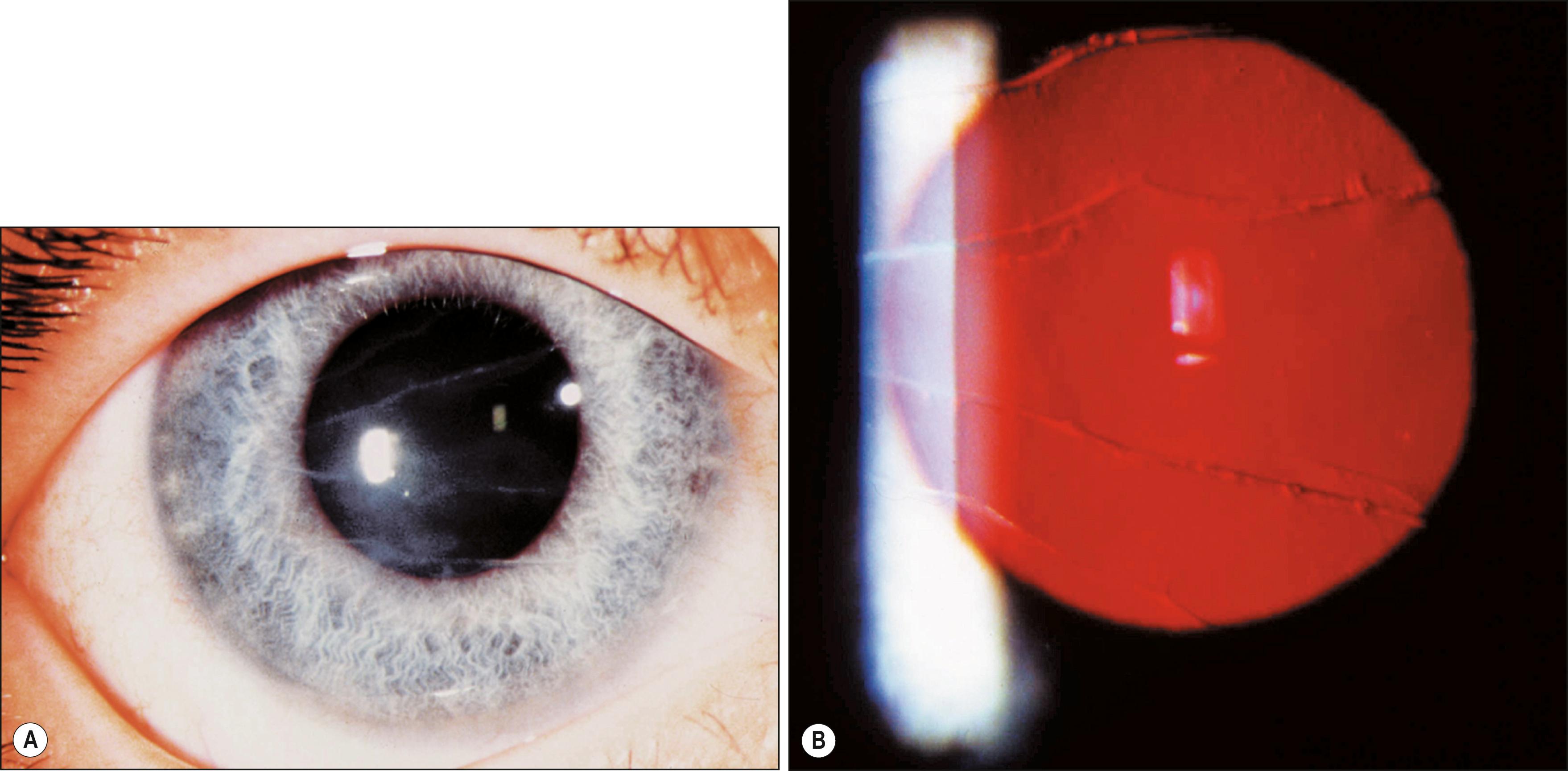
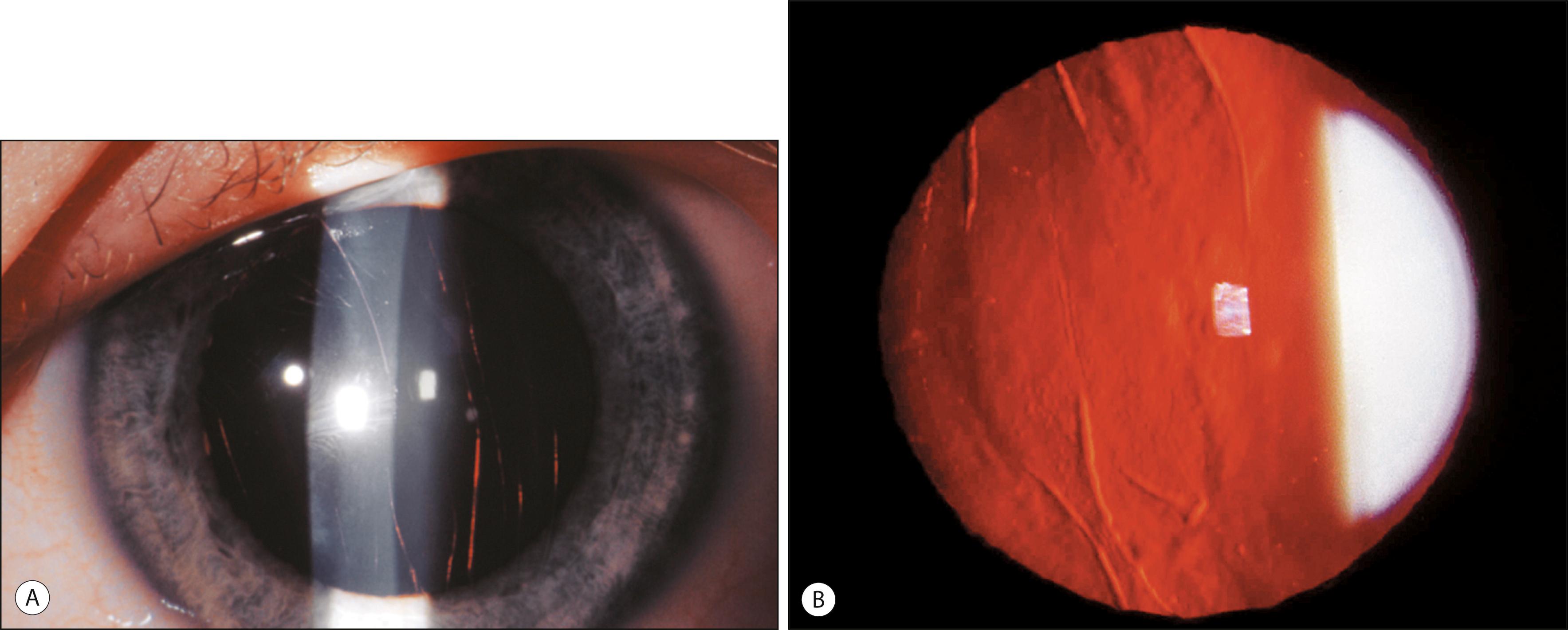
The management of congenital glaucoma is surgical, although topical antihypertensive drops can be employed as a temporizing measure. Procedures should be performed by a glaucoma specialist or a pediatric ophthalmologist experienced in the surgical management of congenital glaucoma. In general, if the view through the cornea allows for direct visualization of the angle, a goniotomy is the procedure of choice. If, however, the cornea is very cloudy, limiting a clear view of the anterior segment structures, a trabeculotomy is the preferred approach. If these procedures fail, trabeculectomy or aqueous shunt implantation may be considered.
Injury to the cornea at birth occurs from accidental placement of the forceps blade across the globe and orbit during delivery, causing acute elevation of IOP with globe distention and subsequent rupture of the Descemet membrane. , Other soft tissue injuries, such as unilateral periorbital edema and ecchymoses, may also occur. Left eyes seem to be affected more commonly than right eyes because neonates usually present in the left-occiput-anterior position. Descemet tears in birth trauma are usually unilateral, central, and, in contrast to congenital glaucoma, occur in a vertical or oblique pattern ( Table 18.2 and see Fig. 18.9 ), presumably because the tip of the forceps has slipped over the rim of the orbit and compressed the globe vertically. Consequently birth trauma produces diffuse stromal and epithelial edema in the immediate postpartum period (see Table 18.2 ). If the damage is not too severe, the corneal edema usually clears within weeks to months. The young endothelium resurfaces the posterior cornea and synthesizes a new thick basement membrane that accentuates the edges of the tear and fills in the area of dehiscence. Once the corneal edema has disappeared, the edges of the break appear as rounded glassy ridges that protrude from the posterior cornea and light up strikingly in retroillumination (see Fig. 18.9B ). Although the cornea remains clear, high residual corneal astigmatism, which may range from 4 to 9D, requires urgent correction and amblyopia treatment. The steep meridian of the astigmatism typically parallels the orientation of the Descemet ruptures. Once the corneal edema has resolved, refraction for glasses or contact lenses should be performed as soon as possible. Early fitting with rigid gas-permeable lenses has been reported to successfully prevent amblyopia secondary to severe astigmatism and anisometropia ( Fig. 18.10 ). However, patching or atropine therapy are typically necessary to treat underlying amblyopia in conjunction with correction of the refractive error. The corneal specialist should work closely with a pediatric ophthalmologist to manage amblyopia effectively. Later in life, the previously stressed endothelium may decompensate, with resulting corneal edema that requires penetrating keratoplasty or endothelial surgery to restore vision. ,
| Birth Trauma | Congenital Glaucoma |
|---|---|
| Normal IOP | High IOP |
| Normal corneal diameter | Large corneal diameter with buphthalmos (may return to normal with IOP lowering) |
| Corneal edema immediately postpartum | Corneal edema weeks or months after birth |
| Corneal edema clears after weeks to months | Corneal edema clears after IOP lowering |
| Vertical or oblique tears in Descemet membrane | Horizontal or concentric tears in Descemet membrane |
| Higher incidence in left eyes, often with other associated soft tissue injuries | Equal incidence between right and left eyes |
| No photophobia | Photophobia present |

A second type of trauma that can cause corneal opacity occurs in amniotic band syndrome. A portion of the amniotic band may stretch across the face in utero, often causing a cleft lip, which is sometimes associated with microphthalmia and a cloudy cornea, possibly secondary to direct corneal trauma as opposed to tears in the Descemet membrane.
Congenital opacities caused by corneal ulcers are rarely present at birth. But when a fluorescein-staining epithelial defect does occur in a neonate, the ophthalmologist should consider infectious and neurotrophic etiologies. This section begins with the infectious agents that are transmitted in utero from mother to fetus and cause congenital corneal opacification at birth without epithelial defects. Then, the discussion goes on to cover the common infectious agents transmitted in the perinatal period that can cause corneal pathology with or without epithelial defects. Last, hereditary causes of neurotrophic keratitis that cause corneal inflammation, sterile ulcers, and subsequent opacification are considered.
Since the widespread implementation of the rubella (German measles) vaccine, which confers lifelong immunity, congenital rubella is rarely seen in developed countries. Primary infection in the adult is typically accompanied by a nondescript catarrhal conjunctivitis. A mild form of follicular conjunctivitis may also occur and, more rarely, mild superficial punctate epithelial keratitis. Permanent corneal disease due to primary rubella infection has not been described. Congenital rubella infection, however, is acquired transplacentally during the first trimester of gestation and represents an uncommon cause of congenital corneal opacity. It is more commonly associated with microphthalmia, cataract, retinitis, iridocyclitis, strabismus, nystagmus, nasolacrimal duct obstruction, and viral dacryoadenitis. , Boniuk has thoroughly described the congenital rubella syndrome, which includes ocular, otic, cardiac, and other visceral anomalies. , Approximately 6% of infants of mothers who acquired rubella in the first trimester of pregnancy manifest a corneal opacity at birth. These congenital corneal opacities secondary to congenital rubella have been subdivided into the following three main groups :
Transient central stromal opacity—clears in the first weeks of life and may result from viral infection of the endothelium.
Transient corneal edema secondary to acute elevated IOP from viremia—usually clears as the pressure spontaneously returns to normal.
Diffuse corneal edema and scarring—is often accompanied by severe microphthalmos with iridocorneal, or keratolenticular adhesions (Peters anomaly).
The diagnosis of rubella-induced corneal opacification is based on history; typical visceral and radiographic anomalies; viral cultures of the throat, urine, or other secretions; and subsequent documentation of characteristic changes in the ocular fundus. Serologies of both infant and mother should be obtained. The presence of rubella-specific IgM in the cord serum confirms the diagnosis, as IgM does not cross the placenta. If the corneal clouding is related to glaucoma or lens-to-corneal touch, these two conditions must be treated appropriately. If the opacification is an isolated finding, it usually resolves spontaneously. If the opacification persists, penetrating keratoplasty may be considered, but this is often challenging due to severe intraocular inflammation and associated ocular abnormalities.
In newborns, infectious diseases of the cornea typically present with signs of infection of the ocular surface, including the conjunctiva. The classic schematic for the differential diagnosis of infectious neonatal conjunctivitis has been based on the timing of onset of symptoms, with early onset (within a few days) considered typical of gonorrheal conjunctivitis and onset within the first week typical for chlamydial conjunctivitis. Later onset, up to 2 weeks after birth, is most common for herpes simplex virus (HSV) infection, although it should be noted that more usual causes of bacterial and viral conjunctivitis can present at any time in the postnatal period and may require fortified topical antibiotics if there is no response to commercially available ophthalmic antibiotic preparations. As mentioned earlier, bacterial corneal ulcers do not occur in utero and are exceedingly rare in the neonate. However, in the late 19th and early 20th centuries, bacterial conjunctivitis in the newborn commonly produced corneal ulceration and blindness. The advent of 1% silver nitrate prophylaxis and many effective topical antibiotics virtually eliminated bacterial corneal ulceration in this age group. Nonetheless, early diagnosis and treatment of suspected neonatal conjunctivitis is critical to preventing poor outcomes, such as a perforated corneal ulcer.
The etiology of neonatal conjunctival infection is thought to be multifactorial. The neonate is exposed to many bacteria in the birth canal, and the duration of exposure, integrity of the ocular surface, and adequacy of antibiotic prophylaxis all factor into the development of ocular infection. Many gram-positive and gram-negative organisms have been implicated in these infections; however, the two that are of utmost importance to diagnose quickly are those with the risk of systemic complications.
Neisseria gonorrhoeae can cause serious ocular and systemic complications if not treated appropriately. Gonorrheal ophthalmia neonatorum usually presents as a bilateral conjunctivitis with an incubation period of a few hours to a day or two. The disease is initially characterized by lid edema, severe bulbar conjunctival injection, chemosis, and a watery or serosanguineous discharge. After 4 or 5 days, the disease enters the purulent stage, with increasingly copious purulent discharge and the formation of a pseudomembrane on the tarsal conjunctiva. Untreated, the conjunctival inflammation will slowly decrease, but conjunctival scarring may occur. The cornea can be involved, displaying peripheral or central corneal infiltrates, which may quickly ulcerate and progress to perforation. Systemic treatment is always required in cases of suspected gonorrheal conjunctivitis due to the risk of disseminated gonorrheal infection, which can cause meningitis and severe sepsis. Treatment consists of broad-spectrum intravenous ceftriaxone. Local treatment of the eyes typically includes saline irrigation of the fornices and administration of a topical antibiotic. The infant and mother should be treated for presumed chlamydial infection, given the high rate of coinfection by these two organisms.
Neonatal conjunctivitis caused by Chlamydia , albeit a more common cause of ophthalmia neonatorum, rarely produces corneal ulceration or opacification. Erythromycin is given systemically to treat associated systemic chlamydial infection.
Congenital syphilis is not a cause of congenital corneal opacification. Syphilitic interstitial keratitis occurs bilaterally in the first or second decade of life and is thought to be immunologically mediated.
Become a Clinical Tree membership for Full access and enjoy Unlimited articles
If you are a member. Log in here